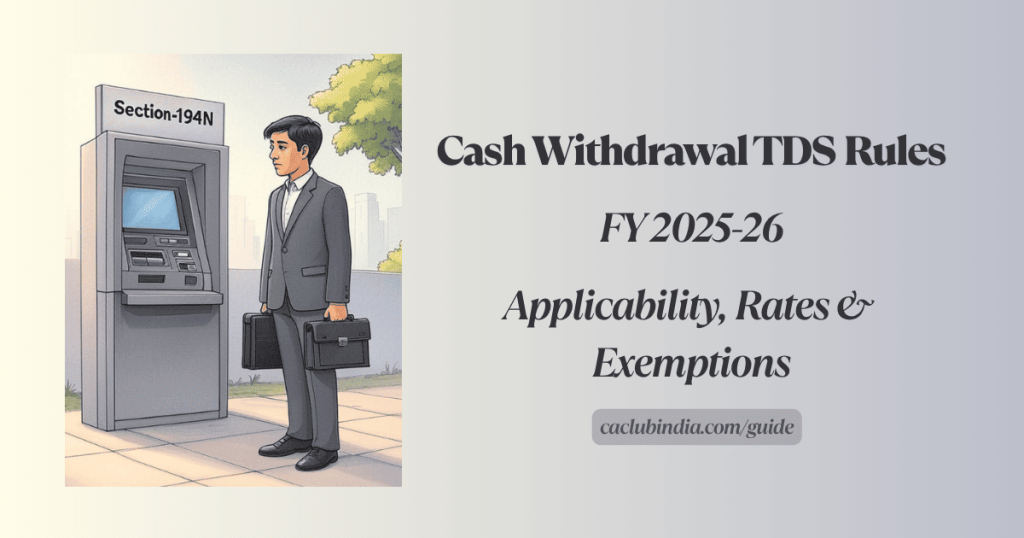TDS on cash withdrawal means that if you take out a large amount of cash from your bank account, the bank might cut a small part of it as tax before giving you the money. This tax is called Tax Deducted at Source (TDS). It’s a rule by the Income Tax Department to keep track of big cash transactions and stop people from avoiding taxes.
When it was introduced?
It was introduced in Union Budget 2019 by Finance Minister Smt. Nirmala Sitharaman to curb the flow of black money and encourage digital transactions.
It is applicable starting from 1st September 2019.
Why this rule?
This rule is mainly to reduce the use of large cash transactions and make the money trail clear. Many people used to take out big amounts of cash and not show in their income or taxes. To stop this, the government started tracking such withdrawals through TDS.
Who needs to worry about it?
Not everyone needs to worry. This TDS rule mostly applies to people or businesses who withdraw more than INR 1 Crore in cash in a year from their bank account. If you haven’t filed your income tax returns (ITR), the limit is even lower – INR 20 Lakh.
TDS Rates for FY 2025-26
TDS is applicable if the cash withdrawal from a bank account exceeds certain limits:
For Regular Taxpayer
| Limits | TDS Rates |
| cash withdrawals over Rs.1 crore in a financial year | 2% |
For – One who not filed ITR for the past 3 years
| Limits | TDS Rates |
| Cash withdrawals exceeding Rs.20 lakhs | 2% |
| Cash withdrawals exceeding Rs.1 crore | 5% |
Who is responsible for deducting TDS on cash withdrawals?
Under Section 194N of the Income Tax Act, if cash withdrawals exceeding Rs 20 lakh or Rs 1 crore (depending on the conditions) TDS is to be deducted by banks (private, public, and co-operative) or post offices before the amount is handed over to the account holder.
The bank keeps track of your total cash withdrawals during the financial year. As soon as your withdrawals cross the limit, the bank will automatically deduct TDS on the extra amount.
Section 194N Applicability
This section is applicable to the withdrawals made by any taxpayer, which include :
- An individual
- A Hindu Undivided Family (HUF)
- A company
- A partnership firm or an LLP
- An Association of Person (AOPs) or Body of Individuals (BOIs)
But, the government has also notified that the provision of this section are not applicable to the persons is payment is made to :
- The Central or State Government
- Banking company(private or public sector)
- A co-operative bank
- A post-office
- Business correspondents of a banking company
- White Label ATM operators of any Bank
- Specified trader or commission agents operating under the Agriculture Produce Market Committee (APMC) vide Notification No. 70/2019-Income Tax Dated 20th September, 2019.
- An authorized dealer or agent/sub-agent of its franchise,
- RBI licensed Full-Fledge Money Changer (FFMC) or any agent from its franchise subject to conditions as per Notification No. 80/2019-Income Tax dated 15th October, 2019.
- Any other person notified by the Government of India
How TDS is calculated if threshold limit exceeds?
If a taxpayer withdraws more than Rs. 1 core in a financial year than the payer is require to deduct TDS @ 2% on the amount which is withdrawn in excess of Rs. 1 crore.
Let us understand this with the help of example.
Anjana has withdrawn cash from the State Bank of India in the FY 24-25 in various phases as under :
| Date | Amount (in lakhs) |
| 21 May 2024 | 40 |
| 20 Jun 2024 | 10 |
| 9 Oct 2024 | 25 |
| 29 Nov 2024 | 25 |
| 03 Mar 2025 | 10 |
Now, in the above example Anjana withdraws up to dated 29 Nov 2024 is Rs. 1 crore which has not crossed the limit. So, there will be no TDS applicable.
But on 03 Mar 2025, Anjana withdraws in excess of Rs. 1 crore. So, TDS @2% will be deducted on the amount of Rs. 10 Lakh i.e., Rs. 20,000.
Compliance Requirements
- Deduction: TDS must be deducted at the time of payment or credit whichever is earlier.
- Payment: The deducted amount must be deposited with the government by 7th of the following month.
- Return Filing: The deductor must report TDS in Form 26QC on a quarterly basis.
Points To Remember
- The TDS limit for bank withdrawals applies individually to each bank account.
- If a person has three bank accounts with different banks, each bank allows withdrawals up to Rs. 1 crore without any TDS deduction.
- The total amount that can be withdrawn without TDS deduction would be Rs. 3 crores (Rs. 1 crore per bank account).
For example
Mr. Deepak has withdrawn cash during the financial year from the following banks :
| Bank | Total cash withdrawn during the FY 23-24 (in Rs) |
| HDFC Bank | 70 lakh |
| SBI Bank | 45 lakh |
| Canara Bank | 25 lakh |
Even though Mr. Deepak has withdrawn overall Rs.1.4 crore, no TDS deduction is required because he has not exceeded the Rs. 1 crore limit in any individual bank account.
The TDS limit applies separately to each bank account, not collectively across all accounts.
How to check if TDS was cut?
After your withdrawal, you can check your bank statement or ask the bank for a TDS statement (Form 16A). This certificate shows how much tax was deducted. You can also see TDS details on the TRACES website or your Form 26AS in your income tax account.
Rebate u/s 87A in New & Old Tax Regime For FY 24-25 Click Here
FAQs
Yes, if too much TDS was deducted, you can claim a refund when you file your income tax return (ITR). The TDS amount will be adjusted against your total tax liability. If your total tax liability is less, the government will pay back the extra money to you.
Yes, TDS can apply to both savings and current accounts if the withdrawal crosses the limit.
No, the limit is counted on total withdrawals in a year, not per transaction.
No, TDS on cash withdrawal applies only to actual cash taken out, not digital transfers.
The recipient of cash transactions cannot furnish Form No. 15G/15H or apply for a lower deduction certificate u/s 197 as these provisions are not applicable to cash withdrawals covered under section 194N of the Income Tax Act.


